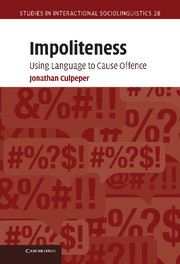Book contents
- Frontmatter
- Contents
- List of figures and tables
- Preface
- Introducing impoliteness
- 1 Understanding impoliteness I: Face and social norms
- 2 Understanding impoliteness II: Intentionality and emotions
- 3 Impoliteness metadiscourse
- 4 Conventionalised formulaic impoliteness and its intensification
- 5 Non-conventionalised impoliteness: Implicational impoliteness
- 6 Impoliteness events: Co-texts and contexts
- 7 Impoliteness events: Functions
- 8 Conclusions
- Notes
- References
- Index
4 - Conventionalised formulaic impoliteness and its intensification
Published online by Cambridge University Press: 16 May 2011
- Frontmatter
- Contents
- List of figures and tables
- Preface
- Introducing impoliteness
- 1 Understanding impoliteness I: Face and social norms
- 2 Understanding impoliteness II: Intentionality and emotions
- 3 Impoliteness metadiscourse
- 4 Conventionalised formulaic impoliteness and its intensification
- 5 Non-conventionalised impoliteness: Implicational impoliteness
- 6 Impoliteness events: Co-texts and contexts
- 7 Impoliteness events: Functions
- 8 Conclusions
- Notes
- References
- Index
Summary
Introduction
Goffman (1967: 89) discusses ‘ritual affronts’ or ‘profanations’ performed by patients in psychiatric wards, varying from hurling abuse to hurling faeces, and notes that these acts are, ‘from the point of view of society at large and its ceremonial idiom’, ‘calculated to convey complete disrespect and contempt through symbolic means’. This chapter focusses on the symbolic linguistic means for conveying impoliteness. It is not, of course, the case that any particular linguistic form guarantees an evaluation of impoliteness in all contexts; moreover, people may disagree about how impolite a linguistic form is. However, the current tendency in the (im)politeness literature of emphasising the context rather than linguistic form risks throwing the baby out with the bath water. Virtually no study has attempted to understand how the notion of conventionality might be linked to politeness or impoliteness. The notable exception is Terkourafi's (e.g. 2001, 2002, 2005a, 2005b) work on a frame-based approach to politeness, and this will provide the basis for my own discussion of conventionalised impoliteness. Moreover, the importance of accounting for conventionalised impoliteness formulae is even greater than accounting for politeness formulae, as I will argue in this chapter and in Section 6.6, because the negative effects of impoliteness formulae and behaviours, especially when highly offensive and thus salient, are not easy to eliminate by means of the context (e.g. understanding them to be part of friendly banter between friends). Such conventionalised behaviours/formulae must be a focal point of study.
- Type
- Chapter
- Information
- ImpolitenessUsing Language to Cause Offence, pp. 113 - 154Publisher: Cambridge University PressPrint publication year: 2011

